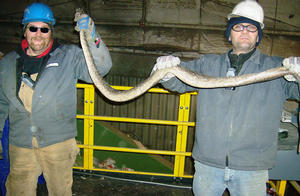Pythons In The Sewers?
Posted by: Loren Coleman on April 4th, 2009
The headlines locally were good ones to hear as folks are coming out of winter into mud season. We enjoy our beautiful city by the bay.
“Portland is #1!”
“Portland, Maine, a historic port city that has transformed itself into a vibrant community of posh restaurants and shops and white-collar businesses, has been named the most livable city in America by Forbes.com,” wrote the Boston Globe.
Portland’s Commercial Street was recently voted one of the country’s great streets by the American Planning Association.
But what happens outside the view of the visiting tourists, humm?

Ecomaine employees Charlie Radley and Goran Dobric display a dead 7-foot-long python they found recently while handling recycled materials at the Portland, Maine, facility.
It’s nice that southern Mainers are getting into the spirit of recycling.
But you knew someone had gone too far when ecomaine, the Portland-based waste agency, issued these new recycling guidelines this week:
Newspapers – yes.
Glass bottles – yes.
Milk jugs – yes.
Snakes – no.
Someone, it seems, decided to recycle a 7-foot-long python. The snake, already dead, arrived at ecomaine’s giant recycling center in Portland a couple of weeks ago, mixed in with tons of paper, glass and plastic. A couple of workers saw it on a conveyer belt just before the snake got fed into the giant sorting machine,
…writes John Richardson in a Portland Press Herald column for April 4, 2009.
You can read the column about the money and other mundane things found in the trash of the city where I live. I’m interested in the wildlife tidbits.
Recycling Manager John Morin said they also “commonly find deer parts during hunting season, and uncooked packaged turkeys after Thanksgiving.”
At ecomaine’s waste-to-energy incinerator, where the real trash goes, workers found “two discarded pet birds, still alive and flapping.”
Although the City of Portland little realizes, of course, that have one of the world’s foremost “experts” on the legends of alligators-in-the-sewers living right here in their midst, I wondered if the newspaper item would get around to the crazy crocs in this hometown article. They did, sort of, oh so indirectly.
Richardson ends his article with this:
No giant pythons or other exotic wildlife has been disposed of in the city’s sewers, said John Emerson, Portland’s wastewater facilities manager.
Those, it seems, are put in the recycling bins.
The recycled python created a stir at ecomaine.
“It’s not too often you get to see a 7-foot python,” Morin said.
Once the snake was determined to be long dead, the workers were happy to hold their trophy for photos. (The more interesting finds often get documented for ecomaine’s internal newsletter.)
Morin said he believes the snake was dead when its owner decided a recycling bin was the easiest way to get rid of it.
The python was a first for ecomaine, which is constantly working to educate people about what gets recycled and what doesn’t, said Shelley Dunn, a spokeswoman.
For the record, if you need to discard a dead snake, you should take it to a veterinarian to be cremated, Dunn said.
After having its photo taken, the misplaced python met a similar fate, in ecomaine’s incinerator.
“So, in a way, it did get recycled,” Morin said. “We did turn it into electricity.”
##############
Your contributions to the research is greatly appreciated. Only $90 has been received in the last three weeks. Even your $10 donation assists in conjunction with that from others. Thank you.
About Loren Coleman
Loren Coleman is one of the world’s leading cryptozoologists, some say “the” leading living cryptozoologist. Certainly, he is acknowledged as the current living American researcher and writer who has most popularized cryptozoology in the late 20th and early 21st centuries.
Starting his fieldwork and investigations in 1960, after traveling and trekking extensively in pursuit of cryptozoological mysteries, Coleman began writing to share his experiences in 1969. An honorary member of Ivan T. Sanderson’s Society for the Investigation of the Unexplained in the 1970s, Coleman has been bestowed with similar honorary memberships of the North Idaho College Cryptozoology Club in 1983, and in subsequent years, that of the British Columbia Scientific Cryptozoology Club, CryptoSafari International, and other international organizations. He was also a Life Member and Benefactor of the International Society of Cryptozoology (now-defunct).
Loren Coleman’s daily blog, as a member of the Cryptomundo Team, served as an ongoing avenue of communication for the ever-growing body of cryptozoo news from 2005 through 2013. He returned as an infrequent contributor beginning Halloween week of 2015.
Coleman is the founder in 2003, and current director of the International Cryptozoology Museum in Portland, Maine.










Good story in the spirit of “Alligators in the Sewer.”
And in your neck of the woods!!!
Maybe Stephen King can make a story out of this!!! 🙂
I feel sorry for the snake D:
Too bad the picture is too small for detail. Is a Burmese, retic, carpet, African rock or a color morph of one of those? You folks with the photoshop programs, analysis this and post so we can figure out what kind of python it was. Thanks.
It’s a Burmese. Enlarge the photo about 300% and you can discern the pattern on its back and also its head.
Poor guy. Probably a pet that was neglected to death.